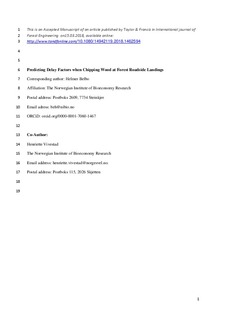| dc.contributor.author | Belbo, Helmer | |
| dc.contributor.author | Vivestad, Henriette | |
| dc.date.accessioned | 2019-05-15T11:17:42Z | |
| dc.date.available | 2019-05-15T11:17:42Z | |
| dc.date.created | 2018-12-20T08:59:54Z | |
| dc.date.issued | 2018-05-15 | |
| dc.identifier.citation | International Journal of Forest Engineering. 2018, 29 (2), 128-137. | nb_NO |
| dc.identifier.issn | 1494-2119 | |
| dc.identifier.uri | http://hdl.handle.net/11250/2597679 | |
| dc.description.abstract | Chipping of bulky biomass assortments at roadside landings is a common and costly step in the biomass-to-energy supply chain. This operation normally involves one chipping unit and one or several transport trucks working together for simultaneous chipping and chip transport to a terminal or end user. Reducing the delay factors in these operations is a relevant ambition for lowering supply costs. A method to estimate organizational delay based on: (1) the capacity ratio between the transport and the chipper, (2) the use of buffer storage, and (3) the number of transport units involved is suggested here. Other delays will also be present, and some of these may relate to the working conditions at the landing. A method to set a landing functionality index based on characteristics of the forest landing is also suggested. A total of 14 roadside chipping operations were assessed and the operators were interviewed to address the impact of machinery configuration and landing characteristics on machine utilization. At most sites, the chipper was the more productive part, and the chipper utilization was to a large extent limited by organizational delay. Still the utilization of the transport units varied between 37 and 97%, of which some 36% of the variation was explained by the landing functionality index. Knowledge from the work presented here should be a good starting point for improving biomass supply planning and supply chain configuration. | nb_NO |
| dc.language.iso | eng | nb_NO |
| dc.subject | Woodchip supply | nb_NO |
| dc.subject | Forest operations | nb_NO |
| dc.subject | Machine utilization | nb_NO |
| dc.subject | Chipping | nb_NO |
| dc.subject | Woodchip transport | nb_NO |
| dc.title | Predicting delay factors when chipping wood at forest roadside landings | nb_NO |
| dc.type | Journal article | nb_NO |
| dc.type | Peer reviewed | nb_NO |
| dc.description.version | acceptedVersion | nb_NO |
| dc.rights.holder | © 2018 Forest Products Society | nb_NO |
| dc.subject.nsi | VDP::Landbruks- og Fiskerifag: 900::Landbruksfag: 910::Planteforedling, hagebruk, plantevern, plantepatologi: 911 | nb_NO |
| dc.subject.nsi | VDP::Landbruks- og Fiskerifag: 900::Landbruksfag: 910::Landbruksteknologi: 916 | nb_NO |
| dc.subject.nsi | VDP::Landbruks- og Fiskerifag: 900::Landbruksfag: 910::Skogbruk: 915 | nb_NO |
| dc.source.pagenumber | 128-137 | nb_NO |
| dc.source.volume | 29 | nb_NO |
| dc.source.journal | International Journal of Forest Engineering | nb_NO |
| dc.source.issue | 2 | nb_NO |
| dc.identifier.doi | 10.1080/14942119.2018.1462594 | |
| dc.identifier.cristin | 1645969 | |
| dc.relation.project | Norges forskningsråd: 228726 | nb_NO |
| dc.relation.project | Norges forskningsråd: 193817 | nb_NO |
| cristin.unitcode | 7677,2,0,0 | |
| cristin.unitname | Divisjon for skog og utmark | |
| cristin.ispublished | true | |
| cristin.fulltext | postprint | |
| cristin.qualitycode | 1 | |
